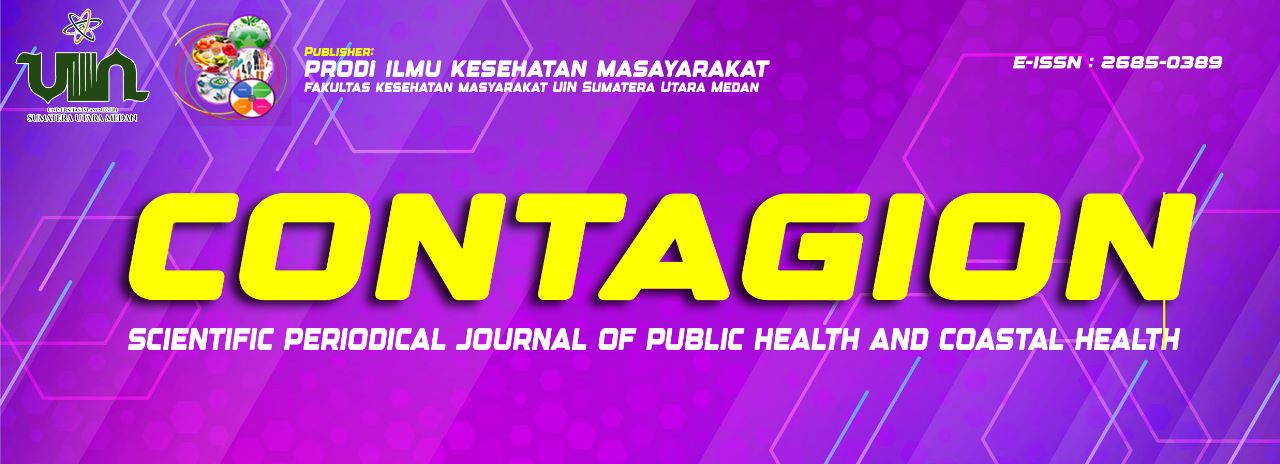Evaluating SIMPUS Implementation at Teladan Community Health Center: a HOT-Fit Framework Analysis
Abstract
Community Health Centers are required to implement a Community Health Center Information System (SIP) in accordance with Minister of Health Regulation No. 31 of 2019. Medan Teladan Community Health Center has implemented various information systems, one of which is e-Puskesmas, but still found obstacles. This study aims to evaluate the implementation of the Management Information System (SIMPUS) at Medan Teladan Community Health Center using the Human Organization Technology (HOT)-Fit method. This type of research is descriptive qualitative research. The study was conducted at Medan Teladan Community Health Center starting from December 2024 - July 2025. Informants in this study were 5 people consisting of the head of the community health center and medical record officers as key informants, registration officers, SP2TP officers and pharmacy service officers as supporting informants. Data analysis was carried out by data reduction, data presentation and drawing conclusions to identify relevant finding patterns in each aspect of HOT-Fit. The results of the study obtained an evaluation of the implementation using the HOT-Fit method on the human aspect, the user side has problems with input errors, where around 60% of informants reported data input. Organizational aspects, the organizational structure is in place, monitoring and evaluation have been carried out and guidelines for using the information system are in place even though they only adopt those from the Ministry of Health. Technology aspects, the quality of the system is still not optimal because the system has not been integrated with all programs and frequent server disruptions or data bridging failures, differences were also found between drug data in the system and actual stock in the pharmacy warehouse. Net benefit aspects, this system has succeeded in reducing dependence on manual processes and increasing data accuracy, but data integration across all programs is still an obstacle. It is recommended to the Medan City Health Office to encourage the integration of information systems between programs into one platform and ensure server stability.
Keywords: System evaluation, information system, HOT-Fit
Full Text:
PDFReferences
Alami, H., Lehoux, P., & Fleet, R. (2020). How can health systems learn from international evidence on health IT implementation. BMC Medical Informatics and Decision Making, 20(1), 133.
Cahyani, A. P. ., Hakam, F., & Nurbaya, F. (2020). Evaluasi Penerapan Sistem Informasi Manajemen Puskesmas (SIMPUS) Dengan Metode HOT-Fit di Puskesmas Gatak. Jurnal Manajemen Informasi dan Administrasi Kesehatan (JMIAK), 3(2), 20–27.
Dinh-Le, C., Chuang, R., & Kvedar, J. C. (2021). Addressing workload burden in health information systems: organizational support and culture. Journal of the American Medical Informatics Association, 28(3), 546–553.
Dinkes Sumut. (2018). Rencana Strategis Provinsi Sumatera Utara tahun 2013 - 2018.
Gurung, R., Jha, A. K., & Sharma, A. (2021). Strengthening health information systems in Nepal: Lessons from the integration of program data using DHIS2. Health Policy and Planning, 36(5), 679–686.
Harjuitana, U., & Santoso, D. B. (2018). Evaluasi Penerapan Sistem Informasi Manajemen Puskesmas (SIMPUS) dengan Metode HOT-Fit di Puskesmas Sedayu I Bantul Yogyakarta.
Jaspers, M. W. M., Peute, L. W., & de Keizer, N. F. (2022). Quality of health data and clinical decision-making. Journal of Biomedical Informatics.
Kemenkes RI. (2019). Rencana Strategis Kementerian Kesehatan 2015-2019.
Kemenkes RI. (2021). Transformasi sistem kesehatan nasional: Enam pilar transformasi. Jakarta: Kemenkes RI.
Khan, A., Akter, S., & Kabir, M. A. (2022). Interoperability issues in digital health systems: A developing country perspective. BMC Health Services Research, 22(1), 987.
Lee, J., Park, J., & Choi, S. (2021). Impact of System Downtime on Health Services: Evidence from Primary Health Care Centers. International Journal of Medical Informatics.
Lippeveld, T., Sauerborn, R., & Bodart, C. (2020). Design and Implementation of Health Information Systems. In World Health Organization.
Luna, D., Almerares, A., & González Bernaldo de Quirós, F. (2022). Health informatics infrastructure and service delivery: Evidence from primary health care facilities. Journal of Biomedical Informatics.
Luna, D., Mayan, J. C., & García Dieguez, M. (2014). Challenges and lessons learned in developing health information systems in Latin America. Studies in Health Technology and Informatics, 205, 1135–1139.
Mikkelsen-Lopez, I., Shango, W., Ziegler, B., & Macwan’gi, M. (2020). SmartCare: Zambia’s nationwide electronic health record system. Global Health: Science and Practice, 8(3), 528–538.
Nguyen, L., Bellucci, E., & Nguyen, L. T. (2022). Enhancing guideline use in digital health systems: A review of barriers and facilitators. BMC Medical Informatics and Decision Making, 22(1).
Pal, D., Paul, S., & Wong, J. (2023). ICT-based health information systems in rural South Asia: A multi-country review. International Journal of Medical Informatics, 173.
Permenkes RI No 31. (2019). Permenkes RI. Nomor 31 Tahun 2019 Tentang Sistem Informasi Puskesmas. Menteri Kesehatan Republik Indonesia Peraturan Menteri Kesehatan Republik Indonesia, No. 999(999), 1–288.
Pusdatin Kemenkes RI. (2019). Pusat data dan teknologi informasi. https://www.kemkes.go.id/folder/view/01/s%0Atructure-publikasi-data-pusat-data-daninformasi.html.
Putri, & Nurlaela, S. (2023). Analisis kesenjangan pelayanan kesehatan melalui pemanfaatan SIMPUS: Studi di daerah tertinggal. Jurnal Administrasi dan Kebijakan Kesehatan, 8(2), 89–100. Jurnal Administrasi dan Kebijakan Kesehatan, 8(2), 89–100.
Putri, R. A., Yusof, M. M., & Rahman, A. A. (2024). Capacity building in public health informatics: Case study in Indonesian PHC. BMC Health Services Research, 24(1), 154.
Rasid, K., Lutfi, S., & Abdullah, S. D. (2022). Penerapan Metode Human Organization Technology and Benefit (HOT Fit) untuk Evaluasi tingkat keberhasilan layanan sistem (studi kasus : Sistem Informasi Akademik (SIMAK) Versi 2 Universitas Khairun Ternate). JATI (Jurnal Jaringan dan Teknologi Informasi), 1(1), 19–27.
Siregar, E. (2018). Faktor-Faktor yang mempengaruhi Manajemen Pendidikan dan Pelatihan (Diklat) dalam upaya pengembangan sumber daya manusia (SDM). Jurnal Dinamika Pendidikan, 11(2), 153.
Sugiyono. (2017). Metode Penelitian Bisnis: Pendekatan Kuantitatif Kualitatif, Kombinasi, dan R&D. Alfabeta.
WHO. (2022a). Digital health systems: A framework for analysis and improvement.
WHO. (2022b). Global Strategy on Digital Health 2020–2025. Geneva: WHO.
Yusof, M., Kuljis, J., & Papazafeiropoulou, A Stergioulas, L. (2008). An evaluation framework for Health Information Systems: human, organization and technology-fit factors (HOT-fit) Epub 2007 Oct 26. PMID: 17964851. Int J Med Inform, 77(6), 98–386. https://doi.org/doi: 10.1016/j.ijmedinf.2007.08.011
DOI: http://dx.doi.org/10.30829/contagion.v7i2.25522
Refbacks
- There are currently no refbacks.
Copyright (c) 2025 Ahmad Fuadi Nasution, Sri Lestari Ramadhani Nasution, Ermi Girsang

This work is licensed under a Creative Commons Attribution-ShareAlike 4.0 International License.






